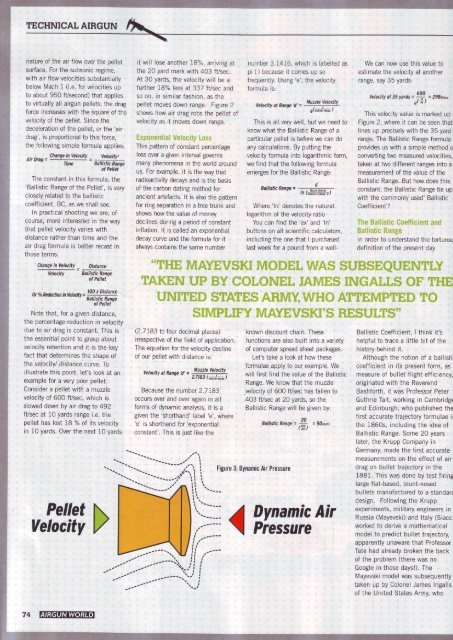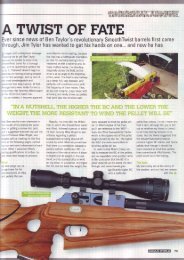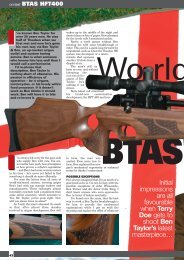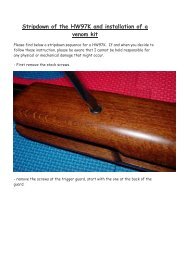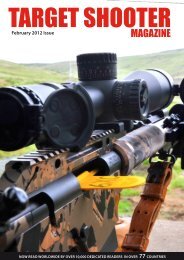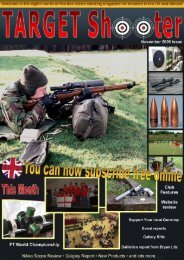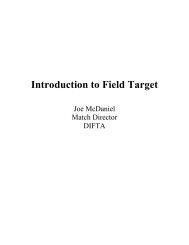THE BALLISTIC COEFFICIENT EXPLAINED
THE BALLISTIC COEFFICIENT EXPLAINED
THE BALLISTIC COEFFICIENT EXPLAINED
- No tags were found...
Create successful ePaper yourself
Turn your PDF publications into a flip-book with our unique Google optimized e-Paper software.
nature of the air flow over the pelletsurface. For the subsonic regime,with air flow velocitiesubstantiallybelow Mach 1 (i.e, for velocities upto about 950 fVsecond) that appliesto virtually all airgun pellets, the dragforce increases with the square of thevelocity of the pellet. Since thedeceleration of the pellet, or the 'airdrag', is proportional to this force,the following simple formula applies:Air Drag = Change in Velocity _ VetocityzTine Ballistic Ratngeof PelletThe constant in this for:mula, the'BallisticRange of the Pellet', is veryclosely related to the ballisticcoefficient, BC, as we shall see.In practical shooting we are, ofcourse, more interested in the wavthat pellet velocity varies withdistance rather than time and theair drag formula is better recast inthose terms:Change in Vetocity _ DistanceVelocity Ballistic Ranqeof Pellet0r o/o.Reduction lA0in Velocity =x DistanceBallistic Ranoeof Pellet'Note that, for a given distance,the percentage reduction in velocitydue to air drag is constant. This isthe essential pointo grasp aboutvelocity retention and it is the keyfact that determines the shape ofthe velocity/ distance curve. Toillustrate this point, let's look at anexample for a very poor pellet.Consider a pellet with a muzzlevelocity of 600 fVsec, which isslowe down by air dragto 492ft/sec at 10 yards range i.e. thepellet has lost 18 % of its velocityin 10 yards. Over the next 10 yardsit will lose another 18%, arriving átthe 20 yard mark with 403 ftlsec,At 30 yards, the velocity will be afurther 18% less at 337 ft/sec andso on, in similar fashion, as thepellet moves down range. Figure 2shows how air drag robs the pellet ofvelocity as it moves down range.HxpmlrerltimB Veimcüty H-*ssThis pattern of constant percentageloss over a given interval governsmany phenomena in the world aroundus. For example, it is the way thatradioactivity decays and is the basisof the carbon dating method for'ancient artefacts. lt is also the patternfor ring separation in a tree trunk andshows how the value of moneydeclines during a period of constantinflation. lt is called an exponentialdecay curve and the formula for italways contains the same numbernumber 3.1416, which is labelled aspi () because it comes up sofrequently. Using'e',,the velocityformula is:Muzzle VelocityVelocitY at Range'd'= --¡------,elBail¡stlc?ilgeThis is all very well, but we need toknow what the Ballistic Range of aparticular pellet is before we can doany calculations. By putting thevelocity formula into logarithmic form,we find that the following formulaemerges for the Ballistic Range:Ballistic Range =d,-tn(ffi¡,)'We can now use this value toestimate the velocity at anotherrange, say 35 yards:vetocity at 3s rards =frl=29}ntsThis velocity value is marked up ,Figure 2, where it can be seen thatlines up precisely with the 35 yardrange. The Ballistic Range formulprovides us with a simple methodoconverting two measured velocitietaken at two different ranges into ameasurement of the value of theBallistic Range.,But how does thisconstant, the Ballistic Range tie upwith the commonly used'' BallisticCoeff icient'?Tttm ffimHtistüe ffioeffisfrmmt arldffimtlistüc ffiangmIn order to understand the torturodefinition of the present:dayWhere'ln' denotes the naturallogarithm of the velocity ratioYou can find the 'ex' and 'ln'buttons on all scientifi calculators,including the one that I purchasedlast week for a pound from a well-**wmmffiffiewffiwffiffiK $vxffiffiffitu wffi ffiffiffiffiffiffiq"ffffiffitr&ffiffiffi Wffi ffi.Y ffiffifuffiffiffifu $'&fuTffiffi ffitrWffi&hfuffi ffiffi WffifffiMHWffiffi ffiWey-ffiffi &ffiffiKwpgffi AwwffiruTffiwffiffi wffiffiKMPfuHffiY ffiXEYffiWffiKK-ffi ffiffiMffifuWffi'-(2.7I83 to four decimal places)irrespective of the field of application.The equation for the velocity declineof our pellet with distance is:Velocity at Range'd' = #ffiBecause the number 2.7783'occurs over and over again in allforms of dynamic analysis, it is agiven the 'shorthand' label'e', where'e' is shorthand for'exoonentialconstant'. This is just like theknown discount chain. Thesefunctions are also built into a varietyof computer spread sheet packages.Let's take a look at how theseformulae apply to our example. Wewill first find the value of the BallisticRange. We know that the muzzlevelocity of 600 fVsec has fallen to403 fVsec at20 yards, so theBallistic Range will be given by:Battistic nanle = = Slyar¿sffiBallistic Coefficient, l th:ink it'shelpful to tr,ace a little bit of thehistory behind it.Although the notion of a balliscoefficient in its present form, asmeasure of bullet flight efficiencoriginated with the ReverendBashforth, it was Professor PeterGuthrie Tait, working in Cambridand Edinburgh, who published thefirst accurate trajectory formulaeithe 1860s, including the idea ofBallistic Range. Some 20 yearslater, the Krupp Company inGermany, made the first accuratemeasurements on the effect of airdrag on bulletrajectory in the1881. This was done by test f irinlarge flat-based, blunt-nosedbullets manufactured to a standadesign. Following the Kruppexperiments, military engineersRussia (Mayevski) and ltaly (Siacworked to derive a mathematicamodel to predict bullet trajectoryapparently unaware that ProfessTate had already broken the backof the problem (there was noGoogle in those daysl). TheMayevski modell was subsequentaken up by Colonel James Ingallof the United States Army, who74m


